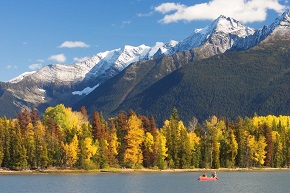Visual Resource Management
The Government of British Columbia is entrusted with managing visual impacts on Crown forest land. B.C.’s visual resource management program conducts a range of activities to ensure the scenic quality expectations of the public and the tourism industry are met. 
Forested hillsides are the features usually identified for scenic management. These steep landscapes support a range of natural resource values, some of them crucial to two key B.C. industries — tourism and forestry. Forestry activities can be managed so they fit with the landscape's natural character and the sensitive landscapes of steep slopes.
B.C.'s reputation as an international tourism destination depends on its spectacular natural beauty. However, tourism and forestry can coexist through innovative forest-management practices. The visual resource management program has a suite of tools to support this coexistence. As well, the Forest and Range Practices Act explicitly identifies the management of scenic values.
Visual quality objectives (VQO) guide forest management activities on a landscape. A poster shows examples of each VQO.
- Handbook: Visual Impact Assessment Handbook (PDF 8MB)
- Poster: A guide to Visual Quality Objectives (PDF 816KB)
- Brochure: Managing change on British Columbia's scenic landscape (PDF 4MB)
- Map: Distribution of VQOs Provincially (PDF 8MB)
Visual Resource Management in Timber Supply Analyses
The following procedures guide tree farm licence (TFL) licensees responsible for timber supply analyses of TFLs on Crown lands. They also assist ministry staff in completing timber supply analyses for timber supply areas. They were developed to meet the needs of current timber supply analysis models and procedures.
The following is a companion to the procedures (which are often referenced as the "grey book").
Visual Management through Harvesting Techniques
Management of visual quality objectives can be achieved through forestry management practices. These areas are not intended to be excluded from harvesting; these areas are required to be managed in a manner that timber harvesting does not compromise the designated objective.
- An Evaluation of Available Merchantable Volume in Areas Subject to Visual Quality Objectives (PDF 861KB)
- Map: Timber Harvesting Landbase within VQOs, Robson Valley Forest District (PDF 1MB)
Wind Energy Developments on Forested Landscapes
The B.C. Government surveyed 591 participants in eight B.C. communities on their responses to 70 scenes of wind-energy developments on forested landscapes:
Contact information
For enquiries about visual resource management in British Columbia, please contact us at:
